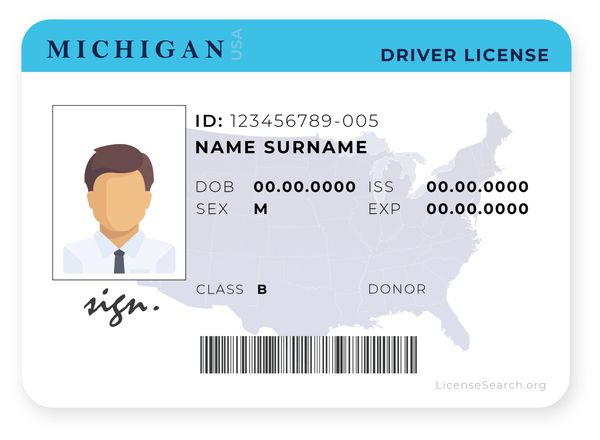
Michigan Driver License
Getting a Level 1 learner’s permit in Michigan
Those, who are under 18, must successfully pass Graduated Driver Licensing before having an adult license. Teenage drivers can obtain a level 1 learner’s license providing that they meet age, education requirements.
Requirements for a learner’s license
- To be eligible for the license, you must be at least 14 years and 8 months old
- You must have your parent or guardian’s permission
- Visit a Secretary of State office and apply for the license in person
- Bring only proper forms of identification
- Complete appropriate driver education, which includes at least 24 hours of classroom instruction, a minimum of six hours of behind-the-wheel instruction and four hours of observation time in a training vehicle
- You must take a knowledge (state) test and score at least 70%
- Finishing the educational program, you will receive the Certificate of completion
- Take the vision test and receive the license (there is no required fee)
Required documents
- Proper forms of identification
- Evidence of legal presence in the US
- Social Security Number
- Documents showing Michigan residence address
- Certificate of Completion
Driving restrictions
- Driving supervised by a licensed adult
- Not using a cell phone while driving
Getting a Level 2 intermediate license in Michigan
Requirements for a license
- Firstly, you must be at least 16 years old
- You must hold your Level 1 learner’s license (for at least six consecutive months)
- Complete a driver education program, which includes a minimum of 6 hours of classroom instruction, as well as a state exam (with 70% passing score)
- Have a clean driving record without any violations, at-fault crashes or suspensions (90 days preceding the application)
- Present a driving log of at least 30 hours of supervised driving (2 hours at night) with your parent, guardian or designated adult
- Complete the remaining hours of the 50-hours practice (10 hours at night)
- Schedule a driving skills test and apply for the license after passing it
- Take the vision test (20/40) and pay the license fee of $25
Required documents
- Completed driving log
- Documents of insurance and registration of the vehicle
- Identification
- SSN and two documents of Michigan residence
Driving restrictions
- Not driving between 10 p.m. and 5 a.m. (unless with a parent, guardian or designated, licensed adult, or for school/employment)
- Using a cellphone only for emergencies
- Not having more than one passenger under the age of 21 in the vehicle
Getting a Level 3 Michigan driver license
This type of license does not have any restrictions and you may drive freely (but with caution).
Requirements for a license
- You must be at least 17 years old
- Hold your Level 2 intermediate license (for at least six months)
- Have driving experience of 12 consecutive months
- You must not have any moving violations, an at-fault crash and license suspension
- There is no license fee
Note that you do not have to visit a Secretary of State office, as the Secretary will automatically upgrade the license and mail it to you. What is more, your parents can delay issuing the license in case they feel you are not ready for safe driving yet.
Get an adult operator’s license
Requirements for a license
- Practice driving for at least 30 hours and schedule a driving skills test
- Pass the test and try not to get more than 25 points (or you will fail)
- Visit a Secretary of State office and present the driving skills certificate, as well as your TIP
- Bring proof of identity (more than one document), proof of residency and legal presence in the United States
- Take the vision test and meet the minimum vision standards (you can wear your corrective/contact lenses and glasses)
- Answer some general health questions as part of the screening procedure
- Receive the Michigan driver’s license by mail in about three weeks
Pay attention to the fact that the Secretary of State will only accept original documents. Photocopies or faxes cannot be used.
Obtaining a commercial driver’s license in Michigan
A commercial driver’s license is necessary for operating vehicles, which require a CDL license.
How to apply
- In the first place, visit a Secretary of State office and apply for the license
- Properly complete the application form and state that you that you meet medical and driver qualifications (sometimes you may need a special form completed by your physician)
- Take the written knowledge and vision acuity tests
- Meet driver record eligibility requirements
- Pay the required fees
- Schedule a CDL driving skills test, pass it and take the results to the office to receive the license
Finding the Michigan driver’s license number
In case you do not remember your driver’s license number, you can find it printed on your vehicle registration. It is also possible to find the number on canceled checks or on a previous driver’s license or ID card.
However, if you are unable to find the number, you may still visit a Secretary of State office and ask for the number. In addition, you will need to present documents of identification.
Michigan point system
According to the Michigan law, some traffic violations may be considered as civil infractions. Based on the violation, there may be fines, special programs and, in some serious cases, even jail time.
Every time a driver violates a traffic rule, there are certain court fines and costs to pay. In addition, every violation has a point value posted to your driving record. Those points remain for two years from the date of conviction.
If there are 12 or more points in two years, a driver will need to undergo a driver assessment reexamination.
In case you think some ticket was not “fair”, you may speak about it when you appear in court.
You may receive six points, for example, for manslaughter, negligent homicide or other felony involving use of a motor vehicle. In similar fashion, you may receive four points for drag racing, impaired driving or failure to yield/show due caution for emergency vehicles.
Other violations include, but are not limited to careless driving, failure to stop at railroad crossing, having an open alcohol container in vehicle and many more.
Michigan driver’s license classifications
Operator’s license
This license, in short, is the most common and standard license to operate a motor vehicle.
Chauffeur’s license
This license, in short, allows the licensee to operate a motor vehicle with a Gross Vehicle Weight Rating (GVWR) of 10,000 pounds or more. It is for employment purposes, such as carrier of passengers or property, bus or school bus drivers.
Commercial driver license
This license, in short, allows the licensee to operate a single vehicle with a Gross Vehicle Weight Rating (GVWR) of 26,001 pounds or more, as well as a combination vehicle. It is also necessary for transporting 16 or more passengers, and hazardous materials.
Motorcycle Endorsement
This license, in short, is for operating a motorcycle.
Costs associated with a Michigan driver’s license
- Operator’s License Fee: $25
- Renewal Fee: $18
- Late Renewal Fee: $7
- Duplicate Fee: $9
- Chauffeur’s License Fee: $35
- Renewal Fee: $35
- Commercial Driver’s License Fee: $25
- Group Endorsement Fee: $5 (each)
- Motorcycle endorsement Fee: $16
- Moped License Fee: $7.50
